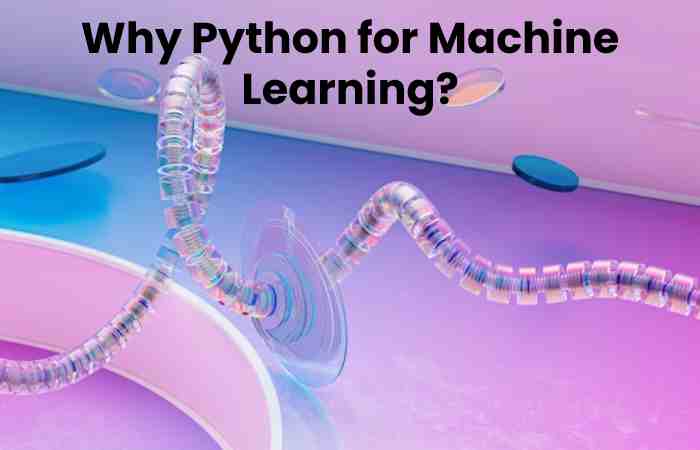Python Machine Learning: Machine learning (ML) is a type of programming that allows computers to automatically learn from data and improve based on experience without being explicitly programmed.
Table of Contents
Introduction
It remains based on algorithms that parse data, learn and analyze it, and then make predictions or intelligent decisions on their own. Machine Learning is frequently confused with Artificial Intelligence due to this clever characterization (AI).
To be precise, machine learning is a subset of artificial intelligence. Machine Learning is simply an application of AI based on the idea that machines require data access to learn and analyze it for themselves.
Why Python for Machine Learning?

Python is easy to understand
To summarise, Machine Learning is simply the recognition of patterns in data to make improvements and intelligent decisions on its own.
Python is the best programming language because it is simple to understand and can remain read for yourself. Its readability, simplicity, and prototyping speed make it a popular language among developers and programmers worldwide.
Python comes with a large number of libraries
Many of these built-in libraries are for Machine Learning and Artificial Intelligence and can remain used immediately.
Among the libraries are:
- scikit-learn is a Python library for data mining, analysis, and machine learning.
- Tensorflow is a neural network library with a high level of abstraction.
- pylearn2 is similar to scikit-learn but more flexible for data mining and machine learning.
Python allows easy and powerful implementation
Python’s simple and powerful implementation makes it one of the top choices for Machine Learning. Other programming languages require coding beginners or students to become familiar with the language before using it for ML or AI.
Python, on the other hand, is not like this. Because of the vast number of libraries, resources, and tools available, you can use Python for Machine Learning even if you only have a basic understanding of the language. Furthermore, Python requires less time to write code and debug errors than Java or C++.
In general, ML and AI programmers would rather spend their time developing algorithms and heuristics than debugging their code for syntax errors.
Friendly syntax and human-level readability
Python is an object-oriented programming language with simple syntax and modern scripting. Python’s scripting nature, designed with almost human-level readability, allows coders and programmers to test their hypotheses and run their algorithms very quickly.
It is why hard-coding structural programming languages like Java, Perl, and C++ remain not commonly used for Machine Learning.
To summarise, whether you are an experienced programmer or a coding novice, Python allows you to do many things and is ideal for performing a complex set of Machine Learning tasks. Python is a preferred, sought-after language skill in the IT world for the reasons stated above.
Community
Finally, Python has widespread support. Because many people, both programmers and average users, regard Python as a standard, its support community is massive, further increasing Python’s popularity.
Python from Machine Learning Projects
Python is a beautiful programming language. However, as a practitioner, you probably don’t want to delve too deeply into the language and instead want to know just enough to get the job done. However, because Python’s ecosystem has grown so large, it’s challenging to know what you should know and skip.
It remains not meant to be your first Python book. However, it could be your second book. We want to learn Python programming so that you can get some work done. Perhaps you can use Python to answer some of the Project Euler or Leetcode questions.
Frequently Asked Questions of Python Machine Learning
What if I Am New to Machine Learning?
This book makes no assumptions about your knowledge of machine learning. It is sometimes utterly unrelated to machine learning.
High-level machine learning is a broad topic. It may refer to how to work more efficiently by utilizing your operating system’s capabilities. It must also remain deployed in a live environment. These are the general skills that can remain applied to any project. You will learn how to do these things in Python.
What if I Am Just Learning Python?
Perfect. This book remains written for you!
What if My Programming Skill is Poor?
You don’t have to be a Python expert to read this book. However, if you’re still unsure, we have some pointers for you to learn the basics of Python, either online or from another book.
Even if you can barely code, you can benefit from this book. First, you’ll understand how to learn from your own mistakes! You will understand how to learn from the code of others.
What if I Am Not a Python Programmer?
Python is the focus of this book. However, the skills you learn from this book will most likely apply to other languages.
A modern debugger, for example, always includes the ability to skip lines, step into a function, set breakpoints, and watch a variable. We show you how to use these to debug a Python program with PDB, but you can also use what you’ve learned to debug a C++ program with GDB.
While you are learning the vast array of libraries available in Python and how to use them, you may be able to find their equivalent in your other language. Again, because we learn from one another, the APIs in different worlds are likely to be very similar.
Conclusion
Python Machine Learning, Third Edition is an in-depth look at machine learning and deep learning in Python. It is a step-by-step tutorial and a reference you will return to as you build your machine learning systems.
Machine learning, the application, and the science of algorithms that make sense of data is the most exciting field in computer science! We live in an era where information is abundant; we can convert this data into knowledge by utilizing self-learning algorithms from a lot of machine learning.
There has probably never been a better time to break into the machine learning field and learn how to use powerful algorithms to spot patterns in data and make predictions about future events, thanks to the many powerful open source libraries that have developed in recent years.
Also read : New Mercedes-Benz Crossover Reviews, Pricing & Specs
Related posts
Featured Posts
Brooks Launch 8 Women
Brooks Launch 8 Women: The Brooks Launch 8 is an impartial lightweight cushioned trainer. The Launch 8 can be a quick…
What is Marketing Icon
Marketing Icon: A marketing Icon is everything in the marketing world. If you want to capture marketing budgets, marketing with…

